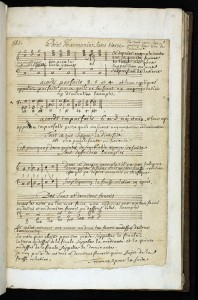A Newly-Identified Theoretical Work by Marc-Antoine Charpentier
 Patricia Ranum has announced the identification of a theoretical work by Marc-Antoine Charpentier bound in an 18th century collection of manuscripts owned by the Lilly Library at Indiana University. Her convincing argument for the attribution of “Manuscript XLI” to Charpentier, as well as reproductions of the twelve page treatise, can be found at her informative and thoroughly engaging website.
Patricia Ranum has announced the identification of a theoretical work by Marc-Antoine Charpentier bound in an 18th century collection of manuscripts owned by the Lilly Library at Indiana University. Her convincing argument for the attribution of “Manuscript XLI” to Charpentier, as well as reproductions of the twelve page treatise, can be found at her informative and thoroughly engaging website.
Ranum’s analysis suggests that the treatise was related to Charpentier’s engagement in the education of Louis XIV’s nephew, Philippe II d’Orléans, Duke of Chartres in the early 1690s and was copied out by the composer himself in Autumn, 1698. Perhaps most the most significant aspect of Ranum’s identification is that details of the manuscript suggest that the composer may have written as many as forty other theoretical works besides the few known that have survived in copies. Sadly it would appear that after his death in 1704, Charpentier’s heirs did not preserve his theoretical works together with his compositions.
Ranum describes how she was introduced to the volume containing Charpentier’s treatise:
Some years ago, I agreed to read and comment upon the transcription and translation of a French manuscript being done by Carla E. Williams, a doctoral candidate in musicology at the University of Indiana, Bloomington. In early November 2009, Ms Williams sent me two computer files: her transcription and translation, plus scans of the manuscript itself, which bears the title Traité d’accompagnement. As I scrolled through her transcription, I came upon the names of Étienne Loulié (on whom I had worked back in the 1980s and Charles Masson (a friend of Sébastien de Brossard, someone I have likewise studied.) Most intriguing of all were some references to “feu Mr Charpentier,” the “late Monsieur Charpentier.”
Since one of the pillars on which the anonymous Traité is constructed is a discussion of major and minor scales and the fundamental chords of each key/mode, I was not overly surprised to find references to Loulié’s and Masson’s published works. Those books included brief presentations of the major and minor scales whose existence their mutual friend, Brossard, claimed to have deduced back in 1684 or 1685.
I checked the images of the original manuscript that Ms Willams had sent me: that was indeed what the anonymous author of the Traité de l’accompagnement had written. Still, I was puzzled by the allusion to the “Principes de Charpentier” (p. 18 of the Traité, my emphasis). To what book or manuscript might the author be referring? Loulié wrote a book called Élements ou Principes, but no such book by Charpentier is known.
“While I’m at it, I might as well scroll through the entire file,” I said to myself, “to get a visual impression of the source. It might help Ms Williams to date her treatise more accurately than simply ‘post-1710′ — the date of the latest publication mentioned.” Toward the end of the Traité, the handwriting changed abruptly: I was looking at the hand of Marc-Antoine Charpentier! The mature hand he used at the Sainte-Chapelle!
Ranum’s full analysis of “Manuscript XLI,” can be read here.